
The Chicago Bears are a professional American football team based in Chicago. The Bears compete in the National Football League (NFL) as a member club of the league's National Football Conference (NFC) North Division. The Bears have won nine NFL Championships, including one Super Bowl, and hold the NFL record for the most enshrinees in the Pro Football Hall of Fame and the most retired jersey numbers. The Bears have also recorded the second-most victories of any NFL franchise, only behind the Green Bay Packers, who they have a long-standing rivalry with.
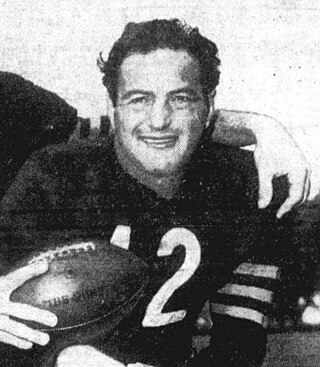
Sidney Luckman was an American football quarterback who played for the Chicago Bears of the National Football League (NFL) from 1939 through 1950. During his 12 seasons with the Bears, he led them to four NFL championships in 1940, 1941, 1943, and 1946.
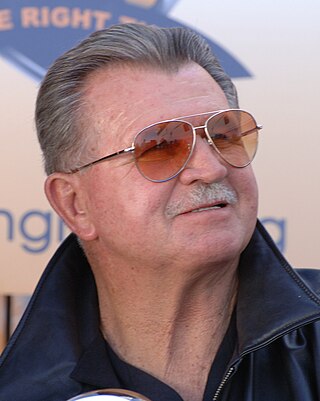
Michael Keller Ditka is an American former football player, coach, and television commentator. During his playing career, he was UPI NFL Rookie of Year in 1961, a five-time Pro Bowl selection, and a six-time All-Pro tight end with the Chicago Bears, Philadelphia Eagles, and Dallas Cowboys in the National Football League (NFL); he was inducted into the College Football Hall of Fame in 1986 and the Pro Football Hall of Fame in 1988. Ditka was the first tight end in NFL history to reach 1,000 yards receiving.

George Stanley Halas Sr., nicknamed "Papa Bear" and "Mr. Everything", was an American football end, coach, and executive. He was the founder and owner of the Chicago Bears of the National Football League (NFL), and served as his own head coach on four occasions. He was also lesser-known as a player for the New York Yankees of Major League Baseball (MLB). He is the namesake for the NFC Championship trophy.

Robert Lawrence Layne was an American professional football quarterback for 15 seasons in the National Football League (NFL). He played college football for the Texas Longhorns before being selected by the Pittsburgh Steelers with the third overall pick of the 1948 NFL draft and traded to the Chicago Bears. Layne played one season with the Bears, and then with the New York Bulldogs in 1949, the Detroit Lions from 1950 to 1958, and the Steelers from 1958 to 1962.
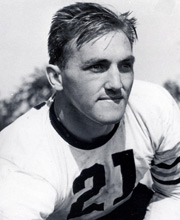
Daniel John Fortmann was an American football guard and linebacker who played for the Chicago Bears in the National Football League (NFL). He played college football for the Colgate Red Raiders. Playing for Chicago from 1936 to 1943, he was selected as an All-Pro for seven consecutive years from 1937 to 1943. He was the Bears' team captain starting in 1940 and led the team to NFL championships in 1940, 1941, and 1943.

George Edward Trafton was an American professional football player and coach, boxer, boxing manager, and gymnasium proprietor. He was inducted into the Pro Football Hall of Fame in 1964 and was also selected in 1969 as the center on the NFL 1920s All-Decade Team.

Joseph Lee Stydahar nicknamed "Jumbo Joe", was an American football player and coach. He was inducted into the Pro Football Hall of Fame in 1967 and the College Football Hall of Fame in 1972.

Stanley Paul Jones was an American football guard and defensive tackle who played in the National Football League (NFL) for the Chicago Bears and the Washington Redskins. He was inducted into the Pro Football Hall of Fame in 1991. Jones is credited as the first professional player to use weight training to improve his conditioning for football.
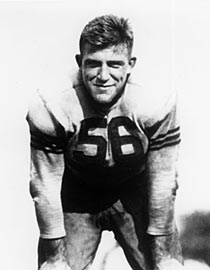
William Ernest Hewitt was an American football defensive end and end who played in the National Football League (NFL). He played five seasons for the Chicago Bears (1932–1936), three for the Philadelphia Eagles (1937–1939), and one for the Phil-Pitt Steagles (1943). He is remembered for his refusal to wear a helmet as one of the last NFL players not to wear one.
Philip Jacob Handler was an American football player and coach who spent his entire professional career in the city of Chicago. He had a seven-year, 53-game NFL playing career, during which he was named All-Pro four times. On three separate occasions, Handler served as head coach of the Chicago Cardinals, and later as an assistant coach for the Chicago Bears. He served as an assistant coach for the Cardinals when they won the 1947 NFL Championship; and with the Bears when they won the 1963 NFL Championship.

John Leo "Paddy" Driscoll was an American football and baseball player and football coach. A triple-threat man in football, he was regarded as the best drop kicker and one of the best overall players in the early years of the National Football League (NFL). He was inducted into the Pro Football Hall of Fame in 1965 and the College Football Hall of Fame in 1974.

Kenneth William Kavanaugh was an American football player, coach, and scout. He played professionally in the National Football League (NFL) for the Chicago Bears as an end from 1940 to 1950, except for three seasons during which he served in World War II. He led the league in receiving touchdowns twice, and is a member of the NFL 1940s All-Decade Team. He is the Bears' all-time leader in receiving touchdowns, with 50. He retired with the second most receiving touchdowns in NFL history and was the second to reach 50 touchdowns in NFL history.
Joseph Francis Fortunato was an American professional football player who spent his entire 12-year National Football League (NFL) career playing linebacker for the Chicago Bears. A five-time Pro Bowl selection, he was the captain and signal-caller for the Bears defense, leading to an NFL Championship in 1963. Fortunato is one of only four players, and the only defensive player named to the National Football League 1950s All-Decade Team who has not yet been enshrined in the Pro Football Hall of Fame.
The 1943 season was the Chicago Bears' 24th in the National Football League. The team failed to match on their 11–0 record from 1942 and finished at 8–1–1, under temporary co-coaches Hunk Anderson and Luke Johnsos. On the way to winning the Western Division, the Bears were, yet again, denied a chance at an undefeated season by the defending champion Redskins in Washington. The Bears had their revenge in the NFL title game and defeated the Redskins at Wrigley Field to claim their sixth league title. It was their third championship in four years, establishing themselves as the pro football dynasty of the early 1940s.
The 1944 season was the Chicago Bears' 25th in the National Football League. The team was co-coached by Hunk Anderson and Luke Johnsos with Paddy Driscoll as the assistant coach.
The 1937 Chicago Bears season was their 18th regular season completed in the National Football League. The Bears started the season fast, winning their first five games, three of them on the road. After a tie to the Giants and a loss to the Packers, the Bears finished the season strong, winning their last four games. The team was second in scoring offense, behind Green Bay, and led the league in scoring defense.
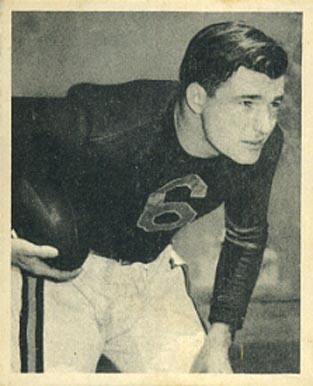
Donald John Kindt, Sr. was an American defensive back and halfback who played nine seasons from 1947 to 1955 for the Chicago Bears in the National Football League (NFL). Kindt played college football for the University of Wisconsin Badgers primarily as a halfback from 1943 to 1946, missing the 1944 and half of the 1945 season because of World War II. He was the starting halfback for the Badgers for most of his college career.
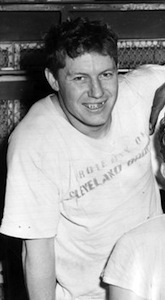
Edgar Francis "Special Delivery" Jones was an American football running back who played for the Chicago Bears of the National Football League (NFL) and the Cleveland Browns of the All-America Football Conference (AAFC). Jones played college football at the University of Pittsburgh where he finished seventh in the Heisman Trophy voting in 1941.
Boris Stephan "Babe" Dimancheff was a Bulgarian-American football halfback in the National Football League (NFL) for the Boston Yanks (1945–1946), the Chicago Cardinals (1947–1950), and the Chicago Bears (1952). He played college football at Purdue University.















